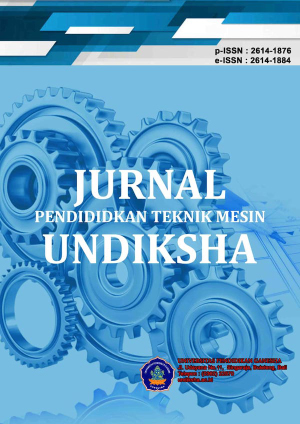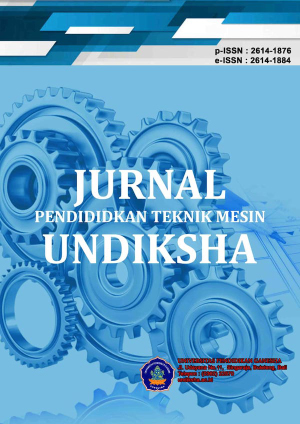Review Pengaruh Range Dan Approach Terhadap Efektivitas Cooling Tower di PT. IP
DOI:
https://doi.org/10.23887/jptm.v9i2.34899Abstract
Saat ini sistem pembangkitan energi di dunia masih didominasi oleh energi fosil. Pada pembangkit listrik tenaga panas bumi, Cooling Tower digunakan untuk sirkulasi air pendingin yang dikontakkan dengan gas tak jenuh , sehingga sebagian dari zat cair itu akan menguap, dan suhu zat cair akan menurun. PT. Indonesia Power Kamojang dalam proses pembangkitan energi listrik menggunakan mesin Cooling Tower untuk melakukan pendinginan. Dalam upaya untuk menentukan performa sebuah mesin Cooling Tower, maka diperlukan pengukuran efektivitas. Dalam penelitian ini dilakukan analisis mengenai efektivitas pendinginan dan pengukuran efektivitas dilakukan dengan nilai approach dan range. Dalam penelitian ini menggunakan metode Overall Equipment Effectiveness, untuk mendapatkan nilai availability, performance efficiency, dan rate of quality. Maka pada saat musim kemarau memiliki efekvtivitas yang lebih baik dibandingkan dengan musim hujan. Hal ini disebabkan oleh faktor lingkungan, serta temperatur air kondensat yang masuk ke dalam Cooling Tower. Semakin tinggi temperatur air kondensat yang masuk, maka efektivitas pendinginan di dalam Cooling Tower semakin rendah karena proses pendinginan tidak maksimal. Hal ini menyebabkan temperature yang dihasilkan oleh Cooling Tower tidak mencapai temperature yang diinginkan.
Kata kunci: Cooling Tower; Efektivikasi; Performansi
Currently, the energy generation system in the world is still dominated by fossil energy. In geothermal power plants, Cooling Tower is used to circulate cooling water that is contacted with unsaturated gases, so that some of the liquid will evaporate, and the temperature of the liquid will decrease. PT. Indonesia Power Kamojang, in the process of generating electrical energy, uses a Cooling Tower engine for cooling. In an effort to determine the performance of a Cooling Tower engine, it is necessary to measure its effectiveness. In this study, an analysis of the effectiveness of cooling was carried out and the measurement of its effectiveness was carried out using the approach and range values. In this study using the Overall Equipment Effectiveness method, to get the value of availability, performance efficiency, and rate of quality. So during the dry season it has better effectiveness than the rainy season. This is due to environmental factors, as well as the temperature of the condensate water that enters the Cooling Tower. The higher the temperature of the incoming condensate water, the lower the cooling effectiveness in the Cooling Tower because the cooling process is not optimal. This causes the temperature produced by the cooling tower to not reach the desired temperature.
Keywords : Cooling Tower, Effectiveness; Performance
DAFTAR RUJUKAN
Awwaluddin, M., & Santosa, P. (2012). Perhitungan Kebutuhan Cooling Tower Pada Rancang Bangun Untai Uji Sistem Kendali Reaktor Riset. Prima (Aplikasi Dan Rekayasa Dalam Bidang Iptek Nuklir), 9(1), 34–41.
Dewan Energi Nasional. (2020). Bauran Energi Nasional.
Elok nurul Faizah. (2020). Analisa Performa Kinerja Cooling Tower Induced Draft Counter Flow Dengan Bahan Pengisi Aluminium Semicircular ARC.
Kasbani, K. (2009). Tipe Sistem Panas Bumi Di Indonesia Dan Estimasi Potensi Energinya. Buletin Sumber Daya Geologi, 4(3). https://doi.org/10.47599/bsdg.v4i3.184
Muhsin, A., & Pratama, Z. (2018). Analisis Efektivitas Mesin Cooling Tower Menggunakan Range and Approach. Opsi, 11(2), 119. https://doi.org/10.31315/opsi.v11i2.2552
Triyansah, O., & Witanto, Y. (2020). Efektivitas cooling tower fan 6p - 4051 – gb. di pt. pupuk sriwidjaja sektor stg – bb, palembang, sumatera selatan. Rekayasa Mekanik, 4 No 1, 9–12.
Widyaningsih, G. A. (2017). Peraturan Presiden Nomor 22 Tahun 2017 tentang Rencana Umum Energi Nasional. Jurnal Hukum Lingkungan Indonesia, 4(1). https://doi.org/10.38011/jhli.v4i1.53
Gunawan, Y., Setiadanu, G. T., Zuhaidi., Ahadi, K., & Didi Sukaryadi, S. N. (2020). Karakteristik Operasi Sistem Orc Di Sumur Pad 29a Pt . Geodipa Energi Dieng Operating Characteristics Of Orc System. 19(1), 1–12.
Downloads
Published
Issue
Section
License

Jurnal Pendidikan Teknik Mesin Undiksha is licensed under a Creative Commons Attribution-ShareAlike 4.0 International License.










